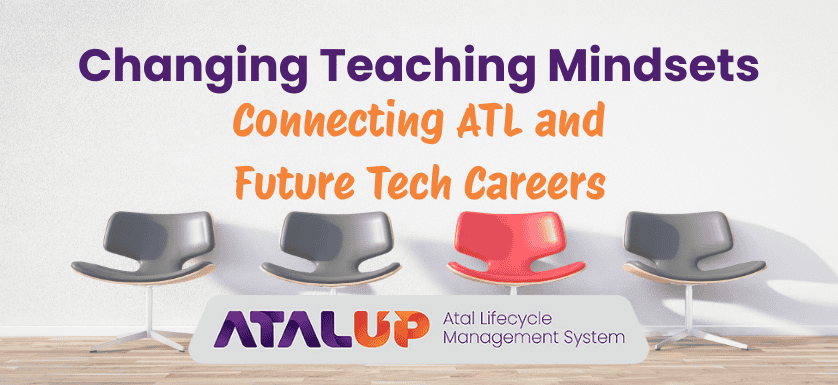
ATL and future tech careers are deeply connected. Atal Innovation Mission has a crystal clear vision: 1 million young innovators in India. For years, many schools in India’s rural areas and some in urban areas have focused only on theoretical education. The previous Indian education system was designed to strengthen theory. In most Indian schools, practical exams usually carry 20% to 30% of the total marks in science subjects like Physics, Chemistry, and Biology.
The world has been growing at a rapid pace in the areas of innovations, science, and technology. With the boom of Artificial Intelligence and Machine Learning, companies are emphasizing hiring candidates who are proficient in the latest technology and critical thinking.
The current Indian education system identified this problem and decided to focus on hands-on learning by introducing STEM education in the curriculum.
ATL and Future Tech Careers: Job Boom in AI, ML, and Robotics
According to CIO news, jobs in Artificial Intelligence and Machine Learning are seeing a 37% year-to-year increase in India. Every common person is using AI to simplify complex tasks. Be it WhatsApp or Instagram, AI is everywhere. The reason behind this boom in AI is its simplicity.
According to the Economic Times, the AI sector in India is expected to create approximately 2.3 million jobs by 2027. These job opportunities can turn the tables of Indian economic conditions and help our future youngsters secure promising careers.
As per Business Standard News, the rise of AI and automation necessitates the upskilling and reskilling of approximately 16.2 million workers in India by 2027 to bridge the skill gap and meet industry demands. Atal Tinkering Lab is designed to fulfill such requirements and help students get hands-on experience in the latest technologies like AI, ML, IoT, and Robotics.
ATL and Future Tech Careers: A Shift in Teacher Mindset
Atal Tinkering Labs (ATL) are driving a major shift in the way STEM education is approached in Indian schools. The change is not limited to students alone. Teachers are transforming, too. ATL is actively influencing how they teach, engage, and guide students in the classroom.
For years, science and technology education in schools was theoretical. Teachers focused on completing the syllabus and preparing students for exams. STEM was restricted to definitions and diagrams. ATL disrupted that pattern. It brought tools, activities, and hands-on learning into everyday teaching.
The role of teachers is no longer limited to giving instructions. ATL encourages them to take on the role of facilitators and mentors. With access to new-age tools like microcontrollers, sensors, 3D printers, and robotics kits, teachers are now experimenting along with students. This shift helps them rediscover their own curiosity and creativity.
ATL also ensures that teachers receive the right training. They are introduced to design thinking, basic electronics, prototyping, and innovation challenges. These training sessions build technical confidence and shift their mindset from conventional to progressive.
When teachers are confident and open to learning, students automatically feel encouraged. ATL creates this collaborative atmosphere. Teachers no longer dismiss “different ideas” as distractions. Instead, they welcome experimentation and support problem-solving. Students start asking more questions. The fear of failure is reduced. The classroom becomes a space for innovation, not just instruction.
The gap between textbook science and real-world STEM applications is finally closing. Students who once memorized formulas now apply them to build real prototypes. They understand the “why” and “how” behind every concept. Teachers support them in connecting academic theory with working models and practical outcomes.
In ATL-enabled schools, student engagement has improved noticeably. Curiosity has replaced silence. Participation has increased. Students look forward to learning because they are doing, not just listening. This would not have been possible without a shift in the teacher’s mindset.
ATL is creating a complete change in school culture. It is not just about setting up a lab. It is about nurturing an innovation-driven environment. Teachers who once feared technology now encourage students to explore it. Students who once struggled with science now build robots and smart systems.
This is real transformation. ATL is helping teachers become enablers of the future. It is giving students a head start in careers related to AI, robotics, space tech, and more. Most importantly, it is bridging the gap between education and application.
STEM is no longer just a subject. It is becoming a way of thinking. Thanks to ATL, both teachers and students are learning to innovate, adapt, and lead.
ATALUP’s Critical Role in ATL and Future Tech Careers
While ATL provides the foundation, ATALUP ensures the journey is structured, efficient, and impactful. It simplifies the entire lifecycle of ATL implementation, from grant application and lab setup to scheduling, learning, and performance tracking. With its powerful system, ATALUP empowers teachers with real-time insights, ensures curriculum integration, and helps schools align with national benchmarks. It acts as a single platform to manage, monitor, and maximize ATL success. In short, ATALUP bridges the gap between intent and execution, making the ATL vision truly achievable.